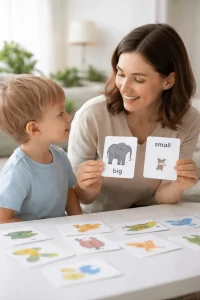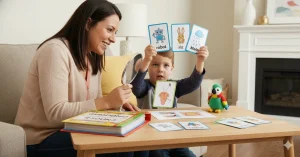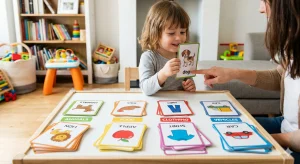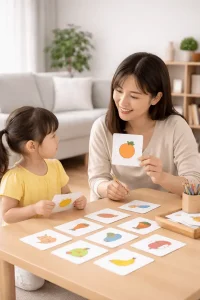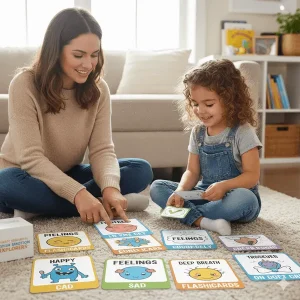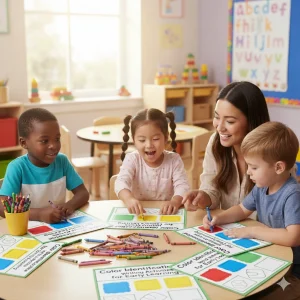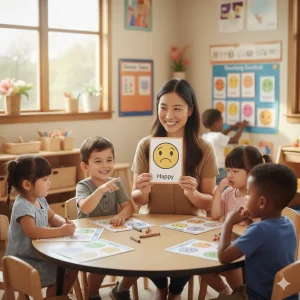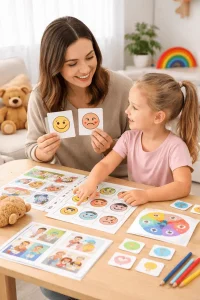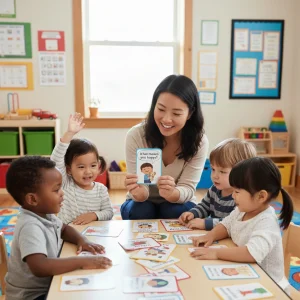Simple Mindfulness Techniques to Reduce Distractions in Kids
By Wellness Hub
Last Updated: September 25, 2024
Have you ever noticed how easily kids get distracted? Whether it’s a buzzing phone, a noisy environment, or simply daydreaming during schoolwork, distractions are a common challenge. But there’s a way to help children stay focused and calm amidst all the chaos: mindfulness.
Mindfulness is all about being present in the moment, paying attention to what’s happening right now, and doing it without judgment. It’s like pressing the pause button on the rush of daily life, allowing kids to reset and refocus. Research has shown that mindfulness can help children manage their emotions, reduce stress, and improve concentration. Imagine your child being able to complete tasks without constantly drifting off or needing endless reminders. Sounds great, right?
Understanding Mindfulness for Kids
So, what exactly is mindfulness, and why is it such a buzzword these days, especially for kids? In simple terms, mindfulness means paying full attention to what you’re doing right now without getting lost in other thoughts or worries. It’s like focusing on a single task, like eating your favorite ice cream, and truly enjoying every bite without thinking about the homework due tomorrow or that new game you want to play. It’s all about being present in the moment.
Now, you might wonder, why is mindfulness so important for kids, especially in today’s fast-paced digital world? Kids today are surrounded by screens, notifications, and constant stimuli that make it incredibly easy for their minds to wander. From video games to social media, there’s always something competing for their attention. This can lead to distractions, difficulty in focusing on schoolwork, and even increased stress levels. By practicing mindfulness, kids learn how to bring their attention back to the present moment, which can significantly help them manage these distractions.
Also read: How to Teach Mindfulness to Kids in Online Sessions
Common Causes of Distractions in Kids
It’s no secret that kids today face a world full of distractions. From the constant ping of digital devices to the endless noise of busy environments, it’s easy for their attention to be pulled in a hundred different directions. Let’s take a closer look at some of the most common distractions kids encounter and how these impact their learning and daily lives.
1. Digital Devices
Tablets, smartphones, and video games are often at the top of the list when it comes to distractions for kids. With so many apps, notifications, and games designed to capture their attention, it’s easy for children to get lost in screens for hours. This screen time can interrupt their focus, making it harder to concentrate on schoolwork or even basic tasks like tidying up their room.
2. Noisy Environments:
Whether it’s a bustling household, a loud classroom, or the background noise of TV and conversations, noise can be a major distraction for kids. It can be challenging for children to filter out these sounds, which can cause their concentration to waver. Imagine trying to read a book while a TV blares in the background; it’s tough for adults and even harder for kids whose brains are still developing the ability to filter distractions.
3. Overstimulation:
In today’s fast-paced world, kids are often bombarded with too much information at once. Bright lights, fast-paced media, and even crowded spaces can overwhelm their senses, leading to overstimulation. When kids are overstimulated, it’s difficult for them to focus on one thing, and they may become restless or anxious, making it hard for them to settle down to complete tasks.
4. Impact on Learning and Daily Activities:
These distractions don’t just interrupt a moment of play—they can have a significant impact on a child’s ability to learn and thrive. In school, distractions can lead to missed instructions, incomplete assignments, and a general feeling of falling behind. At home, it can affect everything from getting ready for bed on time to engaging in family conversations. Over time, constant distractions can even impact a child’s self-esteem, as they may start to feel like they’re always behind or not good enough.
5. How Mindfulness Can Help:
This is where mindfulness comes into play. By teaching kids simple mindfulness techniques, like focusing on their breath or practicing mindful listening, we can help them learn to tune out the noise and tune into what’s important. Mindfulness helps kids build the skills they need to manage distractions more effectively, whether it’s putting down the tablet to finish homework or finding calm in a noisy classroom. These techniques don’t just offer a quick fix—they provide lifelong tools that kids can use to navigate distractions in all areas of their lives.
Simple Mindfulness Techniques to Reduce Distractions
Helping kids manage distractions doesn’t have to be complicated. There are simple mindfulness techniques that can be easily integrated into their daily routines, making it fun and engaging for them to practice. Let’s explore a few effective methods that can help your child stay calm and focused.
a. Breathing Exercises
Breathing exercises are one of the easiest and most accessible mindfulness techniques for kids. A simple way to start is with deep belly breathing, also known as “balloon breathing.” Here’s how it works:
- Ask your child to sit comfortably and place their hands on their belly.
- Instruct them to take a deep breath in through the nose, imagining their belly is a balloon that is filling up with air.
- Then, they should slowly exhale through the mouth, letting all the air out of the “balloon.”
- Repeat this for a few minutes, encouraging them to focus only on the sensation of their breath.
b. Mindful Listening
Mindful listening involves focusing entirely on sounds, which helps enhance a child’s attention and reduces external distractions. A simple activity you can try is listening to nature sounds or soft music:
- Have your child sit quietly and close their eyes.
- Play gentle nature sounds, like birds chirping, waves crashing, or soft instrumental music.
- Encourage them to listen carefully and identify different sounds they hear without judging them or getting lost in other thoughts.
c. Body Scanning
Body scanning helps kids become more aware of their bodies and the sensations they experience, promoting relaxation and focus. Here’s a simple guide to get started:
- Ask your child to lie down in a comfortable position and close their eyes.
- Starting from their toes, ask them to slowly pay attention to each part of their body, noticing how it feels without trying to change anything.
- Guide them to move up slowly, focusing on their legs, stomach, chest, arms, and head.
- Encourage them to breathe deeply as they scan each body part, releasing any tension they might feel.
d. Guided Imagery
Guided imagery uses a child’s imagination to create calm and focused states. It’s like daydreaming with a purpose! Here’s an easy exercise:
- Ask your child to close their eyes and imagine their favorite peaceful place—like a beach, a quiet garden, or a cozy room.
- Encourage them to imagine the details: What do they see, hear, and feel? Are there birds, waves, or a gentle breeze?
- Guide them through this imagery, asking them to stay in this peaceful place for a few minutes, focusing on the calming details.
e. Mindful Eating
Mindful eating is a fun and interactive way to teach kids mindfulness. It’s all about paying attention to the act of eating and enjoying every bite. Here’s how to practice it:
- Choose a small snack, like a raisin or a piece of chocolate.
- Ask your child to look at the snack carefully, noticing its color, texture, and smell.
- Have them take a small bite, focusing on how it feels and tastes in their mouth. Encourage them to chew slowly and enjoy the experience.
- Repeat this process, focusing solely on the act of eating without any distractions.
Also read: Online Behavioral Therapy for Kids with Autism
Incorporating Mindfulness into Daily Routines
Incorporating mindfulness into your child’s daily routine doesn’t have to be a big task—it’s all about making small, consistent changes that fit naturally into their day. The key is to keep it simple and make mindfulness a regular habit, just like brushing teeth or reading a bedtime story. Let’s look at some practical ways to weave mindfulness into your child’s everyday life.
Mindfulness Before Homework
Homework time can often be a battleground of distractions. To help your child settle into their homework routine, try a quick mindfulness exercise before they start. A simple breathing exercise or a brief body scan can work wonders. For instance, you could encourage your child to take a few deep breaths to calm their mind and focus on the task ahead. This not only helps clear their mind of distractions but also sets a positive tone for concentrating on their work.
Mindfulness at Bedtime
Bedtime is a perfect opportunity to practice mindfulness, helping your child wind down from a busy day. Try incorporating guided imagery as part of the bedtime routine. Encourage your child to close their eyes and imagine a peaceful place, like a quiet beach or a sunny meadow. Guide them through the scene, focusing on the calming details. This not only relaxes their mind but also prepares their body for sleep.
You can also make bedtime a time for mindful breathing. Encourage your child to lie in bed, place their hand on their belly, and take slow, deep breaths. This simple practice can ease anxiety and help them drift off to sleep more peacefully.
Morning Mindfulness
Starting the day with a bit of mindfulness can set a positive tone for the hours ahead. Consider introducing a morning stretch routine where your child can focus on their movements and how their body feels as they wake up. This could be as simple as stretching their arms overhead, bending to touch their toes, or doing a quick body scan to check in with how they feel.
Another morning option is to practice mindful eating during breakfast. Encourage your child to notice the colors, textures, and flavors of their food. Ask them to chew slowly and enjoy each bite, paying full attention to their meal. This not only helps with mindfulness but also promotes healthy eating habits.
Consistency is Key
The most important part of incorporating mindfulness into your child’s routine is consistency. It’s not about long sessions or perfect practice; it’s about making mindfulness a regular part of their schedule. Even just a few minutes each day can have a big impact. Set aside specific times for mindfulness, like before meals, after school, or right before bed, and try to stick to it.
Over time, these small moments of mindfulness can add up, helping your child develop stronger focus, better emotional regulation, and a greater sense of calm. Consistent practice reinforces the habit, making it easier for kids to tap into these skills whenever they need them.
Incorporating Mindfulness into Daily Routines
| Routine | Mindfulness Activity | Description |
|---|---|---|
| Before Homework | Breathing Exercises | Encourage your child to sit comfortably and take 5-10 deep breaths, focusing on the rise and fall of their belly. This helps clear the mind and sets the stage for focused study time. |
| Morning Routine | Body Scanning | Start the day with a brief body scan: ask your child to slowly notice each part of their body, starting from their toes and moving up to their head. This helps them wake up fully and connect with their body, setting a calm tone for the day. |
| Bedtime | Guided Imagery | Before sleep, guide your child through imagining a peaceful scene, like a beach or a quiet forest. Encourage them to explore the details in their mind, such as the sounds, sights, and smells, to help them relax and drift off to sleep calmly. |
| During Meals | Mindful Eating | During meals, encourage your child to slow down and pay attention to their food. Ask them to notice the colors, textures, tastes, and smells of each bite. This practice not only enhances their eating experience but also teaches them to appreciate their food more fully. |
| After School | Mindful Listening | After a busy day, have your child engage in mindful listening by sitting quietly and focusing on a specific sound, like soft music, the ticking of a clock, or nature sounds. This activity can help them unwind, relax, and transition smoothly into their evening routine. |
Tips for Parents and Educators
Supporting kids in practicing mindfulness can be a rewarding experience for both parents and educators. By creating the right environment and setting a good example, you can make mindfulness a fun and effective part of a child’s daily routine. Here are some practical tips to help you get started:
1. Create a Quiet Space
One of the simplest ways to support mindfulness is by creating a dedicated quiet space where kids can practice without distractions. This doesn’t need to be an entire room—even a small, cozy corner with a cushion, a few calming items like soft lighting, or a plant can work wonders. Encourage your child to spend a few minutes in this space each day, using it as their personal spot for calming down and focusing.
For educators, consider setting up a “quiet zone” in the classroom where students can go when they need a break or a moment to refocus. Even a designated chair or a corner with noise-canceling headphones can make a difference.
2. Be a Mindfulness Role Model
Kids learn a lot by watching the adults around them. By practicing mindfulness yourself, you set a powerful example for your child. Whether it’s taking a few deep breaths when you’re stressed, practicing mindful eating, or simply expressing gratitude, your actions can inspire kids to follow suit.
Share your mindfulness moments with your child, and invite them to join you. For instance, you could say, “I’m going to take a few deep breaths to relax. Would you like to try it with me?” This not only makes mindfulness a shared experience but also shows them that it’s a valuable skill for everyone, not just kids.
3. Encourage Positive Reinforcement
Positive reinforcement can go a long way in encouraging kids to practice mindfulness. Praise their efforts, not just the results. For example, if your child takes a moment to breathe deeply before a big test, acknowledge their effort: “I noticed how you took deep breaths before starting your test. That was a great way to calm down and focus.” This kind of encouragement builds their confidence and motivates them to continue practicing.
In the classroom, teachers can use small rewards, like stickers or extra recess time, for students who use mindfulness techniques to stay focused or calm during challenging moments.
4. Make Mindfulness Fun
Mindfulness doesn’t have to be serious—it can and should be fun! Turn mindfulness exercises into games or creative activities. For example, play a mindful listening game where your child identifies different sounds they hear outside. Or, try a mindful scavenger hunt where they have to find items of different textures around the house.
In school settings, educators can incorporate mindfulness into activities kids already enjoy, like storytelling, art, or music. The goal is to keep it light and engaging so that kids look forward to their mindfulness moments.
5. Keep It Consistent, But Flexible
Consistency is key when it comes to building any new habit, including mindfulness. However, it’s also important to be flexible. If your child isn’t in the mood for a particular exercise, offer another option or try again later. The idea is to integrate mindfulness naturally into their routine without making it feel like a chore.
Benefits of Mindfulness for Kids
Mindfulness isn’t just about sitting still or taking deep breaths; it’s a powerful tool that can bring a range of benefits to kids, helping them navigate the ups and downs of growing up. Let’s take a closer look at how mindfulness can positively impact children’s lives and why incorporating it into their daily routines is so valuable.
1. Improved Focus and Attention
One of the most notable benefits of mindfulness for kids is enhanced focus. With so many distractions in their daily lives—from digital devices to bustling environments—mindfulness helps kids learn to direct their attention intentionally. Simple practices like mindful breathing or listening exercises can significantly boost their ability to concentrate, making tasks like homework or classroom activities less overwhelming.
2. Reduced Anxiety and Stress
Mindfulness offers a natural way for kids to manage anxiety and stress. By teaching them to focus on the present moment rather than getting caught up in worries about the past or future, mindfulness helps kids calm their minds and bodies. Techniques like body scanning and guided imagery can be particularly effective in reducing feelings of anxiety, providing kids with tools to self-soothe when they feel overwhelmed.
For example, a study published in the Journal of Clinical Child & Adolescent Psychology found that mindfulness-based programs in schools led to significant reductions in anxiety and stress among students. These findings support what many parents and educators have observed: that mindfulness helps kids feel more at ease and less anxious in their daily lives.
3. Better Emotional Regulation
Managing big emotions can be tough for kids, but mindfulness teaches them how to pause, observe their feelings, and respond in healthier ways. Instead of reacting impulsively, kids learn to take a moment to breathe and consider their response, which can lead to better decision-making and improved relationships with peers and adults.
Mindfulness practices encourage children to acknowledge their emotions without judgment, which is a critical skill for emotional regulation. Whether it’s dealing with frustration over a tough math problem or sadness from a playground disagreement, mindfulness gives kids the tools to handle their emotions more effectively.
4. Enhanced Overall Well-Being
Beyond just focusing and calming down, mindfulness contributes to a child’s overall sense of well-being. It promotes a positive outlook, encourages self-awareness, and can even improve sleep quality. By regularly engaging in mindfulness exercises, kids develop a stronger connection to themselves, which boosts their self-esteem and resilience.
Many parents and educators have shared their experiences with us at Wellness Hub, noting how children who practice mindfulness seem more balanced and happier overall. The benefits extend beyond immediate relief from stress or distraction; mindfulness helps lay the foundation for a healthier, more mindful approach to life.
5. Testimonials and Evidence
We’ve heard from countless families at Wellness Hub who have seen the positive impact of mindfulness on their kids. One parent shared, “Since my son started practicing mindfulness before homework, I’ve noticed a huge improvement in his focus and attitude. He’s calmer and more willing to tackle tasks without getting frustrated.”
Another testimonial comes from a teacher who incorporated mindfulness into her classroom: “The kids are more settled, and they’re starting to use mindfulness on their own when they feel overwhelmed. It’s been a game-changer for managing classroom behavior.”
Conclusion
Mindfulness is a powerful way to help kids reduce distractions and improve focus, especially in today’s tech-filled world. Simple techniques like deep breathing, mindful listening, and body scanning can teach children to manage their thoughts and stay present. Start small and make mindfulness a fun, daily habit. Whether it’s during homework or at bedtime, these practices can boost focus, reduce anxiety, and enhance emotional well-being. At Wellness Hub, we offer resources to support your child’s mindfulness journey. Let’s help our kids thrive, one mindful moment at a time!
Frequently Asked Questions:
1. What are some simple mindfulness techniques for kids?
Simple mindfulness techniques for kids include deep breathing exercises, mindful listening, body scanning, guided imagery, and mindful eating. These activities help children focus on the present moment and manage distractions effectively.
2. How can mindfulness help reduce distractions in children?
Mindfulness helps children reduce distractions by training their minds to focus on the present moment. Techniques like breathing exercises and mindful listening can improve concentration and help kids handle external and internal distractions better.
3. Why is mindfulness important for kids in today’s digital age?
In today’s digital age, kids are often overwhelmed by screens and constant stimulation, which can make it hard to focus. Mindfulness teaches them how to slow down, be present, and manage their attention, leading to better focus and reduced stress.
4. How do you incorporate mindfulness into a child’s daily routine?
Incorporating mindfulness into a child’s daily routine can be as simple as practicing deep breathing before homework, mindful eating during meals, or guided imagery at bedtime. The key is consistency and making mindfulness a regular, enjoyable part of their day.
5. What are the benefits of mindfulness for kids?
Mindfulness offers many benefits for kids, including improved focus, reduced anxiety, better emotional regulation, and enhanced overall well-being. It helps children develop important life skills that support their mental and emotional growth.
6. How can parents and teachers support mindfulness practice in children?
Parents and teachers can support mindfulness practice by creating quiet spaces, being role models, using apps or resources designed for kids, and making mindfulness fun and engaging. Encouraging regular practice and offering positive reinforcement can also make a big difference.
7. Are there any mindfulness apps recommended for kids?
Yes, there are several mindfulness apps designed specifically for kids, such as Headspace for Kids, Calm, and Smiling Mind. These apps offer guided exercises that are easy to follow and help kids learn mindfulness in a fun way.
8. How long should a mindfulness session be for kids?
Mindfulness sessions for kids can be short and sweet—anywhere from 5 to 10 minutes is a great start. The focus should be on consistency rather than duration, gradually increasing the time as the child becomes more comfortable with the practice.
9. What age can kids start practicing mindfulness?
Kids can start practicing mindfulness as early as preschool age. The techniques can be adapted to be age-appropriate, with simple exercises like deep breathing or mindful listening that are easy for young children to understand and enjoy.
10. How does mindfulness improve focus in kids?
Mindfulness improves focus in kids by training their brains to pay attention to the present moment. Regular mindfulness practice strengthens the brain areas responsible for focus, helping children stay on task and manage distractions more effectively.
About Author:
Lasya Vooturi,
Clinical Psychologist (A) & Behavioral Therapist
Lasya holds a Professional Diploma in Clinical Psychology from Amity University, where she deepened her understanding of psychological principles from March 2023 to March 2024. With over a year of dedicated experience as a Behavioral Therapist, Lasya has honed her skills in applying effective therapy techniques tailored to individual needs. Fluent in Telugu, Hindi, and English, she is adept at connecting with a diverse range of clients, ensuring comprehensive communication and understanding. Lasya’s approach is grounded in empathy and scientific rigor, making her a trusted ally in navigating mental health challenges.
Book your Free Consultation Today
Parent/Caregiver Info:
Client’s Details:
* Error Message
